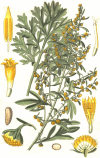Absinthism: a fictitious 19th century syndrome with present impact
- PMID: 16722551
- PMCID: PMC1475830
- DOI: 10.1186/1747-597X-1-14
Absinthism: a fictitious 19th century syndrome with present impact
Abstract
Absinthe, a bitter spirit containing wormwood (Artemisia absinthium L.), was banned at the beginning of the 20th century as consequence of its supposed unique adverse effects. After nearly century-long prohibition, absinthe has seen a resurgence after recent de-restriction in many European countries. This review provides information on the history of absinthe and one of its constituent, thujone. Medical and toxicological aspects experienced and discovered before the prohibition of absinthe are discussed in detail, along with their impact on the current situation. The only consistent conclusion that can be drawn from those 19th century studies about absinthism is that wormwood oil but not absinthe is a potent agent to cause seizures. Neither can it be concluded that the beverage itself was epileptogenic nor that the so-called absinthism can exactly be distinguished as a distinct syndrome from chronic alcoholism.The theory of a previous gross overestimation of the thujone content of absinthe may have been verified by a number of independent studies. Based on the current available evidence, thujone concentrations of both pre-ban and modern absinthes may not have been able to cause detrimental health effects other than those encountered in common alcoholism. Today, a questionable tendency of absinthe manufacturers can be ascertained that use the ancient theories of absinthism as a targeted marketing strategy to bring absinthe into the spheres of a legal drug-of-abuse. Misleading advertisements of aphrodisiac or psychotropic effects of absinthe try to re-establish absinthe's former reputation. In distinction from commercially manufactured absinthes with limited thujone content, a health risk to consumers is the uncontrolled trade of potentially unsafe herbal products such as absinthe essences that are readily available over the internet.
Figures



Similar articles
-
Thujone--cause of absinthism?Forensic Sci Int. 2006 Apr 20;158(1):1-8. doi: 10.1016/j.forsciint.2005.04.010. Forensic Sci Int. 2006. PMID: 15896935
-
[Thujone-attributable effects of absinthe are only an urban legend--toxicology uncovers alcohol as real cause of absinthism].Med Monatsschr Pharm. 2008 Mar;31(3):101-6. Med Monatsschr Pharm. 2008. PMID: 18429531 Review. German.
-
Absinthe--a review.Crit Rev Food Sci Nutr. 2006;46(5):365-77. doi: 10.1080/10408690590957322. Crit Rev Food Sci Nutr. 2006. PMID: 16891209 Review.
-
[Absinthe - history of dependence to thujone or to alcohol?].Fortschr Neurol Psychiatr. 2007 May;75(5):306-8. doi: 10.1055/s-2007-959210. Fortschr Neurol Psychiatr. 2007. PMID: 17506021 Review. German.
-
Wormwood (Artemisia absinthium L.)--a curious plant with both neurotoxic and neuroprotective properties?J Ethnopharmacol. 2010 Aug 19;131(1):224-7. doi: 10.1016/j.jep.2010.05.062. Epub 2010 Jun 11. J Ethnopharmacol. 2010. PMID: 20542104
Cited by
-
Chemical Diversity of Artemisia rutifolia Essential Oil, Antimicrobial and Antiradical Activity.Plants (Basel). 2023 Mar 13;12(6):1289. doi: 10.3390/plants12061289. Plants (Basel). 2023. PMID: 36986977 Free PMC article.
-
Research Advances on Health Effects of Edible Artemisia Species and Some Sesquiterpene Lactones Constituents.Foods. 2020 Dec 30;10(1):65. doi: 10.3390/foods10010065. Foods. 2020. PMID: 33396790 Free PMC article. Review.
-
The Dark Side of "Smart Drugs": Cognitive Enhancement vs. Clinical Concerns.Toxics. 2025 Mar 26;13(4):247. doi: 10.3390/toxics13040247. Toxics. 2025. PMID: 40278563 Free PMC article. Review.
-
Bioactive Compounds, Pharmacological Actions, and Pharmacokinetics of Wormwood (Artemisia absinthium).Antibiotics (Basel). 2020 Jun 23;9(6):353. doi: 10.3390/antibiotics9060353. Antibiotics (Basel). 2020. PMID: 32585887 Free PMC article. Review.
-
Artemisia spp.: An Update on Its Chemical Composition, Pharmacological and Toxicological Profiles.Oxid Med Cell Longev. 2022 Sep 5;2022:5628601. doi: 10.1155/2022/5628601. eCollection 2022. Oxid Med Cell Longev. 2022. PMID: 36105486 Free PMC article. Review.
References
-
- Arnold WN, Loftus LS. Xanthopsia and van Gogh's yellow palette. Eye. 1991;5:503–510. - PubMed
LinkOut - more resources
Full Text Sources

